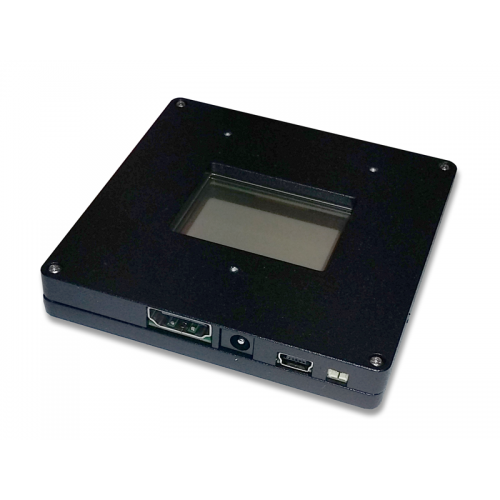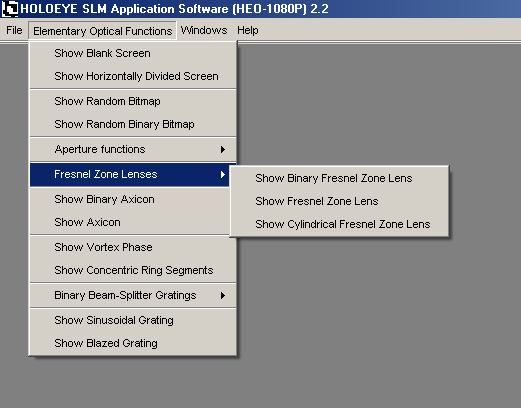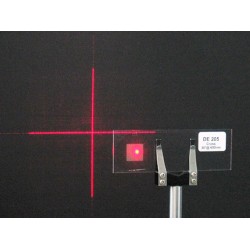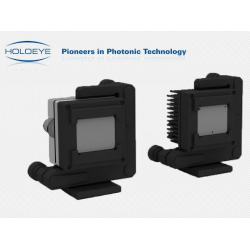LC 2012 - Spatial Light Modulator: 60 Hz XGA

- Stock: Contact us for details
- Click here to: Contact us
- Model: HOLOEYE LC 2012
XGA 60Hz Spatial Light Modulator
LC 2012
- Fill factor: 58%
- Signal type: HDMI
- Transmissive LC
- Panel size 36.9 x 27.6 mm (1.8" Diagonal)

- Pixel pitch: 36 µm
- Resolution XGA (1024 x 768)
- 60 Hz image frame rate
- Amplitude or Phase modulation
- Intensity ratio of 1000:1 @ 633 nm
- 1.8π phase shift at 532 nm
The LC 2012 is based on a transmissive liquid crystal microdisplay with 1024 x 768 pixel resolution. It is addressed using a standard HDMI interface and advanced calibration can be performed using the USB interface.
The SLM provides a phase shift of 2π at 450 nm, 1.8π at 532 nm and 1π at 800 nm. The microdisplay and drive electronics are packaged into a compact box for easy integration into optical setups. The device is delivered with a mounting ring which fits to standard laboratory posts and holders.
LC 2012 SLMs are addressed like an external monitor via a standard HDMI graphics card interface. GUI based calibration and application software (supplied) is used to change geometrical settings, brightness, contrast, and the electro-optical response by applying a new gamma curve. For these advanced callibrations, the USB calibration interface has to be connected via a computer USB port. No additional software or dedicated hardware is required to operate the SLM.
Key Application Software Features
- Computation of computer generated holograms (CGH) from user defined images
- Superposition of CGHs with basic optical functions to combine functionalities
- Generation of SLM signals representing basic optical functions such as lens, grating, axicon and vortex
Applications |
|
|
|
Please contact us for the latest price.
A number of papers have been published by scientists around the globe who have used a HOLOEYE LC 2012 series SLM in their research. Here are some examples:
- Obtaining the curve “Phase shift vs gray level” of a spatial light modulator Holoeye LC2012
- Closed-loop adaptive optics using a single spatial light modulator for ophthalmic applications
- Observation of localized states in Lieb photonic lattices
- Enhanced super resolution using Fresnel incoherent correlation holography with structured illumination
A database of published papers, searchable by device or application, can be also found on the HOLOEYE website here.
Elementary Optical Functions
The HOLOEYE Spatial Light Modulator Pattern Generator software was developed for use with all HOLOEYE SLM models. The software allows the simple generation of diverse dynamic optical functions like gratings, lenses, axicons and apertures as well as the calculation of diffractive optical elements (DOE) from user defined images.
Besides the generation of DOEs a wide range of basic optical functions can be created directly via the menu bar. After input of the required parameters the output image appears in a new window. There are several binary and multilevel optical functions possible:

- Blank Grey Level Screen
With this function you can create a homogeneous gray level screen.
- Horizontally Divided Screen
With this function you will create a horizontally divided screen, consisting of two homogeneous graylevel partial screens.
- Random Bitmap
With this function you will create a random pixel distribution using 256 grayscale values. This function can be used to realize the optical function of a random phase plate.
- Aperture Functions
- Rectangular Aperture
- Circular Aperture
-Single Slit and Double Slit
- Fresnel Zone Lenses
-Binary Fresnel Zone Lens
-Multilevel Fresnel Zone Lens
-Cylindrical Fresnel Zone Lens
- Binary Axicon
With this function you will create a Binary Axicon graylevel image representation.
- Axicon
With this function you will create a 256-level Axicon graylevel image representation.
- Vortex Phase
Use this function to create a 256-graylevel image representation of a vortex phase.
- Concentric ring segments
Use this function to create binary images consisting of concentric ring segments.
- Binary beam-splitter gratings
-Linear Gratings and Crossed Linear gratings
-Exemplary binary beam-splitter designs
- Sinusoidal Grating
With this function you will create a sinusoidal grating.
- Blazed Grating
With this function you will create a blazed grating.
- Calculating a beam-shaping phase function for Gaussian Input beams
-Transformation of a Gaussian beam to a circular ‘flat-top’ beam
-Transformation of a Gaussian beam to a rectangular ‘flat-top’ beam
- Superposition with an additional phase map
- e.g. for compensation of aberrations of the optical system or of the SLM









